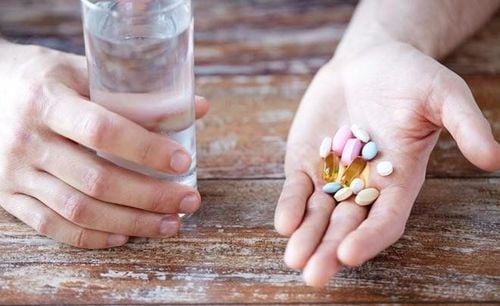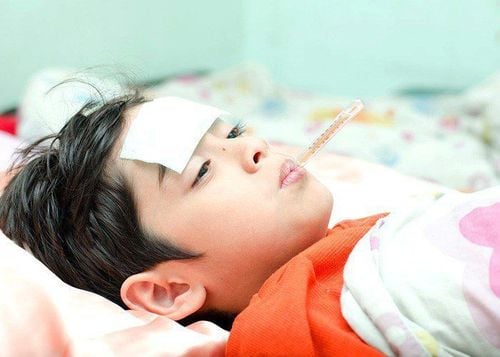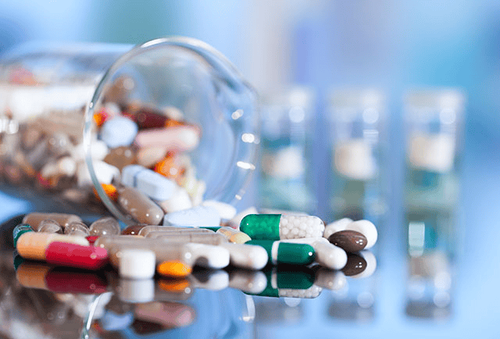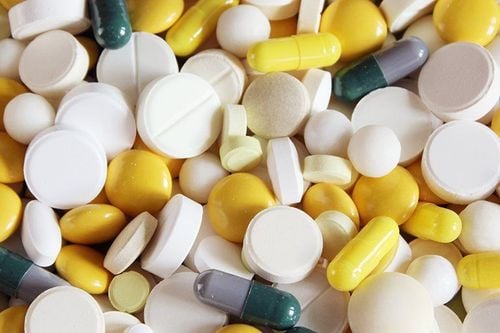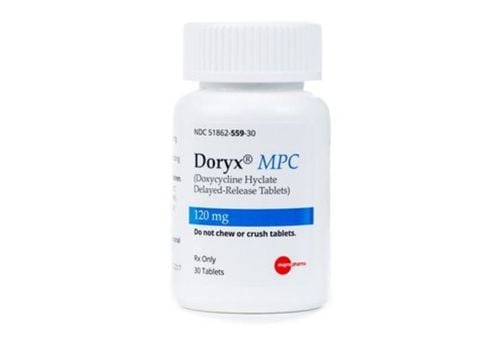This is an automatically translated article.
Posted by Doctor CKII Pham Thi Van Hanh - Pediatric Center - Vinmec Times City International Hospital.Malaria (SR) is an infectious disease caused by the parasite Plasmodium, which is transmitted mainly by Anopheles mosquitoes that bite an infected person and then transmit it to healthy people. Parasites live in erythrocytes, causing typical symptoms of cyclic malaria accompanied by liver, spleen enlargement, anemia, severe complications, brain damage, kidney failure, liver failure, hematuria, dysentery cardiovascular death.
1. Factors that increase malaria transmission
Natural transmission of malaria must satisfy 3 factors:Pathogen: The parasite that causes malaria has 5 species: lasmodium: Plasmodium falciparum, P.vivax, P.malariae, P.ovale and P.knowlesi . In particular, P.knowlesi is a species of parasite that causes malaria transmitted from monkeys to humans, found in Southeast Asia, and in Vietnam, it has been identified in some central mountainous areas (Khanh Hoa, Quang Tri, etc.). .). Malaria is transmitted by the Anopheles mosquito. In Vietnam, there are 2 main vectors, An.minimus, An.dirus and 5 secondary vectors. Sensory block: People who live and work are susceptible to malaria, the disease manifestation depends on the specific immune status for each stage of development of the malaria-causing parasite in the human body. Treatment of malaria is difficult because the parasites that cause malaria are resistant to most antipyretics.
2. Malaria Manifestations
2.1 Clinical manifestations at the onset of malaria The clinical manifestations at the onset of malaria are diverse, patients often have high fever, headache, body aches, anorexia, dark urine. Children are often atypical (continuous fever, abdominal distention, gastrointestinal disturbances, diarrhea, vomiting, lethargy, delirium, rapid weight loss - pseudotyphoid). Pregnant women are prone to miscarriage.2.2 Full-blown stage Symptoms of a typical malaria attack have 3 stages:
Chilling stage: After prodromal: Chills, shivering, shaking hands and feet, children begin to have severe chills, lasting 1-2 now, pale skin, purple lips, cold extremities, rapid pulse, enlarged spleen, frequent urination. Stage of hot fever: Lasting 2-4 hours, high fever 39-40oC, hot skin, congested eyes, headache, muscle pain, back pain, abdominal pain, nausea, little urine, rapid pulse, rapid breathing. .. then the fever subsides. There may be serious complications such as liver failure, kidney failure, convulsions, severe anemia... Stage of sweating: Fever gradually decreases, sweating a lot, thirst, gradually comfortable. Cyclic malaria:
P. ovale and P. Vivax : every 48 hours ; P. Malariae : Every 72 hours ; P. Falciparum : daily bout 2.3 Manifestations of atypical malarial bouts of malaria are often atypical at first infection (primary malaria), when malaria has other comorbid infections, or in young children 6 months to 4 years old: usually no chills, or convulsions when high fever, digestive disorders, rapid anemia, rapid spleen enlargement, hypoglycemia, elevated liver enzymes, acute kidney failure..
Manifestations accompanied by fever Cold: Splenomegaly, anemia increases rapidly after each fever, jaundice with severe hemolysis, possibly hemoglobinuria. Big liver, dark skin, slow physical development...

Biểu hiện cơn sốt rét thường không điển hình khi nhiễm lần đầu
3. Diagnosis of malaria
Based on 3 basic factors: Epidemiology, clinical, laboratory tests for malaria parasites3.1 Epidemiology Live in malaria endemic areas in the mountains and forests in the Southeast region, Central Highlands) or have had malaria in the past the last 6 months. Newcomers to the SR region should note the time from entry to the onset of the first fever. The incubation period of P. Falciparum is 9–14 days; P. Vivax is 12–17 days (up to 6 months); Ovale is 16–18 days; P. Malariae is 18–40 days.
3.2 Clinical Case of clinical malaria: Must meet 4 criteria
Have a typical or atypical fever or have a fever in the last 3 days No other causes of fever found Have or been in a malaria endemic area past 14 days or history of malaria in the last 2 years Responds to antimalarial drugs. 3.3 Testing for malaria parasites Identify cases of malaria:
Uncomplicated malaria/regular malaria: No serious signs and 3 factors: Epidemiology + Clinical typical fever 3 stages or atypical (continuous or fluctuating fever common in children, primary malaria) and other signs (anemia, hepatosplenomegaly) + test for asexual malaria parasites or RDTs presence of malaria antigen or PCR positive for complicated malaria/malignant malaria, severe malaria: Occurs when infected with P. falciparum or in combination with P. falciparum. Infection with P. vivax or P. knowlesi alone can cause severe malaria when resistant to chloroquine . It is important to note the predictive signs of malignant malaria: Consciousness disturbances (lethargy, delirium, fatigue...); persistent high fever; digestive disorders (vomiting, diarrhea, acute abdominal pain); severe headache; high parasite density (P. falciparum ++++ or ≥ 100,000 parasites/μl of blood); severe anemia. Severe manifestations may be seen in P. falciparum malaria : Consciousness disturbance; coma ; exhausted; convulsion more than 2 seizures/24 hours. Acute respiratory failure: dyspnea, SpO2 < 92%, dyspnea, acute pulmonary edema, circulatory failure or shock: rapid, small, difficult pulse. Blood pressure <90 mmHg or 20 mmHg decrease from normal BP according to child's age, cold extremities, oliguria. Acute renal failure: urine <0.5 ml/kg/hour (in both adults and children). Mucosal jaundice. Bleeding spontaneously (subcutaneously, intramuscularly, gastrointestinal bleeding) or at the injection site, or with prolonged bleeding; black stools or vomiting blood. Laboratory tests: Parasite density: >10% of red blood cells infected with P. Falciparum ; Hypoglycemia; metabolic acidosis ; severe anemia; urine with hemoglobin (haemoglobinuria); increased blood lactate >4 mmol/l; blood creatinine > 3mg% (> 265 μmol/l) or blood urea > 20mmol/l; X-ray of the lungs has a blurred image of 2 hilum and lung base; serum bilirubin > 50 μmol/l (3 mg/dl). Malignant malaria in children: Severe anemia, coma, convulsions, hypoglycemia, respiratory failure, metabolic acidosis. Malignant malaria in pregnant women or hypoglycemia or miscarriage, premature birth. Tests to detect malaria parasites in blood: Fingertip blood smear, giemsa staining of thick drops and thin drops to find and classify malaria parasites (determined diagnosis). If the first test is negative, you need to do 3 more times, 8 hours apart while having a fever.

Sốt rét ác tính ở trẻ em cần lưu ý những triệu chứng như hôn mê, co giật
4. Malaria Treatment
4.1 Principles of early detection and treatment. Choose the right drug and the right dose according to the regimen.Artemisinin combination therapy (ACTs) to limit drug resistance and increase efficacy. Combine reliever treatment with radical treatment. Combination of specific treatment, symptomatic treatment, care and improvement of physical condition. Severe malaria requiring transfer to the intensive care unit, monitoring and intensive care 4.2 Treatment of uncomplicated malaria (according to Decision No. 4845/QD-BYT dated September 8, 2016) Antimalarial drugs by patient group and malaria parasite species:
(1) DHA(Dihydroartemisinin)-PPQ (Piperaquin phosphate): Brand name is CV Artecan, Arterakine.
4.3 Based on the diagnosis to choose the right treatment drug. First line treatment according to the guidelines
If the treatment fails, it is necessary to re-test and consider treatment according to the Alternative treatment regimen (Second line). ):
In areas with drug-resistant P. Falciparum malaria: People infected with P. falciparum or in combination with P. falciparum are all treated with anti-resistant malaria regimens: Note that Primaquin should not be given to pregnant women, children under 6 months old and people with G6PD deficiency; Do not give DHA-PPQ to pregnant women during the first 3 months. 4.4 Treatment of complicated malaria (malignant malaria) Combination of specific treatment and supportive treatment:
First line specific treatment: Artesunat injection until the patient is awake and switched to taking DHA- PPQ 3 days. Children < 20kg dose is 3mg/kg. Second line replacement therapy): + Quinine dihydrochloride: injection or intravenous infusion at a dose of 20mg/kg for the first 8 hours, then 10mg/kg every 8 hours, then switch to oral Quinine sulfate + Doxycycline 7 days or DHA-PPQ 3 days dose. Pay attention not to use Artemether for pregnant women in the first 3 months, when using Quinine to prevent hypoglycemia and cardiovascular collapse due to rapid infusion.
4.5 Supportive treatment Hypothermia: Cool compresses + medicine if fever ≥ 38°5C for children or ≥39°C for adults, use only acetaminophen (Paracetamol) 10-15mg/kg/time, 4 times in 24 hour.
Stop seizures: Diazepam 0.1-0.2 mg/kg by slow intravenous injection or rectally (0.5-1.0 mg/kg). Repeat the above dose if convulsion persists, with caution when the child is < 1 year old.
Management of shock: Measure CVP, maintain CVP no more than 6.5 cm H2O using vasopressors Noradrenalin or Dopamine - maintain systolic blood pressure > 90 mmHg. In the case of children with shock, vasopressors should be treated with vasopressors, ensuring systolic blood pressure according to age. Use additional broad-spectrum antibiotics to prevent infection and blood cultures should be taken before use.
Management of respiratory failure: put an oropharyngeal Canule; aspirate sputum widely; lying head high 30°- 45°; nasogastric tube placement; breathing oxygen 4-6 liters/min to maintain SpO2 > 92%;. if Glasgow coma ≤ 10 points, intubation, mechanical ventilation, if severe lung damage, mechanical ventilation according to ARDS; Use antibiotics in case of superinfection, limit tracheostomy and use respiratory suppressants
Management of acute renal failure: in case of acute renal failure with anuria or oliguria, it is necessary to limit fluid intake and maintain fluid balance enter as follows:
If there is a metabolic acidosis (HCO3- < 15 mmol/l): 1.4% sodium bicarbonate infusion. If BP > 90 mmHg, urine < 0.5 ml/kg body weight, need to add furosemide from 40 mg - 80 mg intravenously, monitor renal response and adjust fluids and maintain urine 80-100 ml/ Now, if still no results, dialysis should be performed. Dialysis is indicated when 24-hour urine is < 500 ml after adequate fluid rehydration and diuretic therapy or in patients with edema or threat of acute pulmonary edema or one of the following criteria: Serum creatinine > 500 μmol/ l, blood potassium > 6 mmol/l, pH < 7.25 which cannot be adjusted by bicarbonate; Blood lactate > 5 mmol/l. The interval between dialysis daily or every other day depends on the degree of excess fluid and the patient's condition. Management of anemia due to hemolytic or hemorrhagic: Red blood cell transfusion when Hematocrit < 20% or hemoglobin < 7g/dl.
Management of hypoglycemia: Maintain feeding through a nasogastric tube continuously or with many meals. If hypoglycaemia: slow intravenous injection of 30-50 ml of 20% hypertonic glucose (children 1-2 ml/kg), then maintenance infusion of 10% Glucose continuously for 24 hours to avoid recurrent hypoglycaemia, vice versa If hyperglycemia is >10 mmol/l, continuous low-dose intravenous insulin is given at 1-2 units/hour (maintain blood glucose at about 8-10 mmol/l).
Management of hematuria: Need to ask carefully history, new drugs used, blood test for parasites and urine test for hemoglobin, red blood cell count many times (in hematuria, the number of red blood cells is greatly reduced. rapid) and G6PD test if possible.
Treatment of 0.9% sodium chloride infusion and other fluids to maintain urine output ≥ 2500 ml/24 hours, 10-12 ml/kg/24 hours for children; Transfusion of red blood cells when Hematocrit < 25% or hemoglobin < 7g/dl, if you are taking Primaquine or Quinine, if hematuria occurs, stop the drug immediately and replace it with another antimalarial drug, if renal failure, treat as malignant malaria. .
Note: Hemoglobinuria is common in people with G6PD deficiency, when encountering agents such as drugs, infections and certain foods.
Correction of electrolyte and acid-base disorders: Weigh daily + calculate the amount of fluid in-out. + If there are signs of dehydration: reduced skin elasticity, dry lips, rapid pulse, low blood pressure, little decrease in urine tension: isotonic infusion not exceeding 2.5 liters/day for adults and 20ml/kg for adults. The first 1-2 hours for children + electrolytes, blood pressure, urine. If acidosis (HCO3- <15 mmol/l): administer sodium bicarbonate 1.4% + monitor blood gases.
Pay attention to identify oliguria, anuria by measuring the amount of fluid discharged (urine, vomit...) and the amount of fluid inserted. Care should be taken with rehydration to avoid acute pulmonary edema (especially for patients with renal failure), monitoring of blood pressure, venous pressure.
5. Follow up treatment
5.1 Clinical If the disease is severe or within 3 days of treatment, there is still a fever or the condition worsens and the malaria parasites (parasites) are still present, then use an alternative medicine.If the disease gets worse or within 3 days of treatment, the patient still has a fever or the condition worsens and the malaria parasites are gone – another cause should be sought.
If the patient vomits within 30 minutes of taking the drug, an alternate dose or injection must be taken.
5.2 Parasite monitoring Take blood smears for parasites daily.
Only discharge the patient from the hospital when the scan result is negative.
6. Prevention

Diệt muỗi, tránh để muỗi đốt là cách phòng bệnh đơn giản và hiệu quả
Vinmec International General Hospital is one of the hospitals that not only ensures professional quality with a team of leading medical doctors, modern equipment and technology, but also stands out for its examination and consultation services. comprehensive and professional medical consultation and treatment; civilized, polite, safe and sterile medical examination and treatment space. Customers when choosing to perform tests here can be completely assured of the accuracy of test results.
Customers can directly go to Vinmec Health system nationwide to visit or book an appointment at the website for the best service.
Please dial HOTLINE for more information or register for an appointment HERE. Download MyVinmec app to make appointments faster and to manage your bookings easily.




